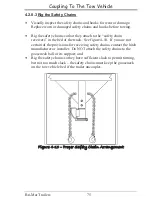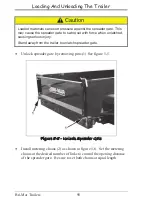
Loading And Unloading The Trailer
Bri-Mar
88
tow vehicle can lose traction or grip and cause loss of control. Also,
even if there is some weight on the tongue, but not enough weight on the
tongue, the trailer can become unstable at high speeds. Remember, the
faster you go the more likely the trailer is to sway.
If, on the other hand, there is too much tongue weight, the tow vehicle is
prone to jack-knife (like the old Corvairs). Furthermore, the front wheels
of the tow vehicle can be too lightly loaded and cause loss of steering
control and traction, if the front wheels are driving.
In addition to tow vehicle control, tongue weight is necessary to insure
that the trailer axle(s) do not exceed their Gross Axle Weight Rating
(GAWR).
In the following table, the second column notes the rule of thumb
percentage of total weight of the trailer plus its cargo (Gross Vehicle
Weight, or “GVW”) that should appear on the tongue of the trailer. For
example, a trailer with a gooseneck hitch, with a loaded weight of 12,000
pounds, should have 20-25% of 12,000 pounds on the tongue. That is,
the example trailer would have 2,400 to 3,000 pounds on its tongue.
Tongue Weight as a Percentage of Loaded Trailer
Weight
Type of Hitch
Percentage
Ball Hitch (or Bumper Hitch)
10–15% for large
trailers
Gooseneck Hitch
Fifth Wheel Hitch
20–25%
Trailers
Summary of Contents for DT508LP
Page 144: ...Electrical Drawings Bri Mar 138 Trailers...
Page 145: ...Bri Mar 139 9 ELECTRICAL DRAWINGS Trailers...
Page 146: ...Bri Mar 140 Trailers...
















































